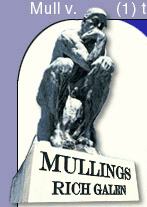|
|

|


The BASICs of Computing
Rich Galen
Thursday May 1, 2014
 Twitter Twitter
Click here for an Easy Print Version
Today, May 1, 2014 is the 50th anniversary of the first use of a computer program that changed my life.
It was developed at Dartmouth College in Hanover, New Hampshire by John G. Kemeny and Thomas E. Kurtz. It was designed to allow non-physicists-mathematicians, and non-engineers to interact with computers and have them do real work.
The name of the program is BASIC - which is an acronym for "Beginner's All-Purpose Symbolic Instruction Code."
I'll tell you why this is such an important date for me. My being able to program in BASIC set the stage - at least tangentially - for everything else I've done.
In the early 1970's I was employed by Marietta College, Marietta, Ohio 45750 in what was known as the Department of Development. Those are the folks that try to get alums - or other interested people to donate to the college.
The only computer on the campus, in those days, was the IBM mainframe in the basement of the administration building. To run anything on that machine required the use of where were known as IBM cards - buff-colored rectangular pieces of thin cardboard with punched holes that told the computer what to do with it.
It was a billion light years away from touching the icon for an app on your smartphone or tablet to make something happen.
It came to pass that the physics, math, and petroleum engineering departments pooled their money and bought what was known as a "mini-computer." That class of computer doesn't exist any more.
This computer had terminals that were teletype machines - typewriters on stands. There was no electronic display.
I was struck by this machine so I went to the college bookstore and bought a book named - essentially - How to Program in BASIC for the Mathematically Impaired.
As you have seen lo these many years, even simple addition and subtraction befuddles me, so I thought this might be a good way to start.
I am no good at math, but I am pretty good at crossword puzzles, so I decided to attack learning how to use computers that way - solving a puzzle.
I remember my first program. It was everybody's first program. Here it is:
10 LET A = 1
20 LET B = 2
30 PRINT A+B
And the machine typed back:
3
Whoo Hoo! It worked!
Over the years I got better at programming but it always came down to "PRINT A + B"
At one point in my career I earned part of my living writing database software using a program called DataBase II that was later purchased by Microsoft.
The most complex program I ever wrote was one that did ticketing and seating for major political dinners. The largest dinner it was ever used for sat about 7,000 people at the Convention Center in Washington, DC.
It was thousands and thousands of lines of code that, if I had to do it from scratch today, I would sit on the curb and cry until someone came along to help me.
Micro-computers began to replace mini-computers, and I was ready for them. When I was the communications director at the National Republican Congressional Committee in the early 1980's we installed three IBM-PCs in my office and used what was known as BBS software - Bulletin Board Software - to communicate with Republican Congressional campaigns across the country using dial-up modems.
Every weekday we published two articles dealing with some floor or committee activity. We added a sample press release based on one of them. Then had a couple of "facts of the day" that the campaign's press secretary could throw into their boss' remarks that night.
We called it the Republican Information Network and, back in the day, the RIN was the envy of the political world.
Putting out MULLINGS on a regular basis involves not just writing the words, but coding them for the website, adding the code for the Secret Decoder Ring page, and then additional coding for the email version.
It all started with my learning how to program in BASIC.
And, as I mentioned above, whether it's getting MULLINGS ready to send out, landing an Apollo spacecraft on the moon, or - dare we say it - programming the webpage that allows people to sign up for Obamacare, all computer programming comes down to:
10 LET A = 1
20 LET B = 2
30 PRINT A+B
On the Secret Decoder Ring page today: Links to the history of BASIC, a photo of an IBM punch card, and a really interesting comparison of IBM-PCs and the Apollo computers.
Also, a Mullfoto from my office window yesterday at the height of the monsoon.
-- END --
Copyright © 2014 Barrington Worldwide, LLC
Become a
Paid Mullings Subscriber!
(To join the FREE mailing list or to unsubscribe Click Here)

Current Issue |
Secret Decoder
Ring | Past
Issues | Email
Rich | Rich
Who?
Copyright �2013 Barrington Worldwide, LLC | Site design by Campaign
Solutions. | |
|



